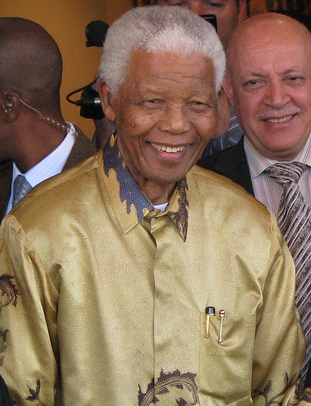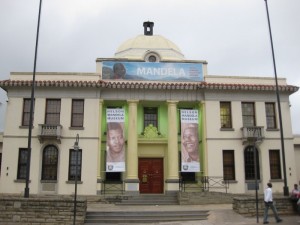
South Africa The Good News / www.sagoodnews.co.za, CC BY 2.0 <https://creativecommons.org/licenses/by/2.0>, via Wikimedia Commons
People interested in following Mandela’s footsteps often wonder where they can experience something of his life without having to go to Robben Island. Robben Island is probably the most iconic visiting point for those who want to follow in Mandela’s footsteps.
However, there are several other places that are just as, if not more, interesting. A visit to any of the following three places will give you a better insight in the life of the statesman.
Life in Qunu
Nelson Mandela spent much of his childhood in Qunu (close to Mthatha) and it is to this area that he retired. Many members of the Madiba clan live in Qunu and the house he built for his family when he returned from Robben Island, is in Qunu.
Qunu is a very rural area, with mud huts and rondavels scattered around the village. The people maintain their traditional lives, and wear their traditional Xhosa clothing. The village is home to the Nelson Mandela Youth and Heritage Centre, which is a component of the Nelson Mandela Museum and allows you a glimpse of Mandela’s footsteps.
The centre offers exhibitions, tours, accommodation and conferencing facilities. One of the exhibitions is of Mandela and Luthuli in conversation. This celebrates the legacy of these two struggle icons and Nobel Prize winners. The exhibition is a compilation of personal exchanges between the two leaders. Writings, photographs, audio material as well as film footage can be seen at the exhibition.

Nelson Mandela Museum
The centre traces the rich history of Mandela and the ANC. Visitors can walk in Mandela’s footprints, going to the various places that he was fond of as a child. There is a replica of his cell on Robben Island, though the view here is one of rolling green pastures. It was in these pastures that a young Mandela would herd cattle and play with his friends.
The ruins of the old single-room Qunu Primary School that he attended can be seen just before the entrance to the Nelson Mandela Youth and Heritage Centre. Also to be seen are the remains of the old stone church where he was baptised, the granite ‘sliding’ rock he used to slide down with friends and the graveyard where his two sons, daughter and parents are buried.
Liliesleaf Farm
Liliesleaf farm, situated in Rivonia, north of Johannesburg, was considered the nerve centre of the liberation struggle. The farm was a secret meeting place for top ANC and Communist Party leaders and it is here that Umkhonto we Sizwe was founded. It was also a hideout of Nelson Mandela.
The raid on Liliesleaf uncovered extensive incriminating evidence that was used by the police to cement their case against several ANC members. It lead to the Rivonia Trial and subsequent sentences of life imprisonment for 8 of the 10 accused – Nelson Mandela and 7 other senior leaders of the ANC.
A visit to Liliesleaf is much more than a dry history lesson. The interactive displays and beautifully restored buildings tell the story of commitment, dedication and sacrifice of many people who fought for freedom. A key component has been the interviewing of numerous individuals linked to Liliesleaf, to build-up a comprehensive audio visual archive of the farm’s history.
The interactive tour takes visitors on a journey, retracing the footsteps of prominent anti-apartheid activists who spent time on the farm.
Located at 7 George Avenue, Rivonia, Johannesburg and open 7 days a week. Telephone +27 11 803 7882/3/4
Mandela House Museum
Nelson Mandela and his family lived in this house in Orlando (Soweto) from 1946 into the 1990’s. He lived for a relatively short period in the house and it was his wife Winnie Madikizela-Mandela with her daughters, who occupied the house while Nelson Mandela was in jail.
The Mandela House at 8115 Orlando West, on the corner of Vilakazi and Ngakane Streets, Soweto, was built in 1945, part of a Johannesburg City tender for new houses in Orlando. The house itself was identical to hundreds of others built on postage-stamp-size plots on dirt roads.
The Museum offers exhibitions with information about the House and the people who lived there and multimedia and audio visual displays.
Booking is not essential, but is encouraged as a maximum of 20 people can navigate the Mandela House site with ease at any one time and there may be a short waiting period until a previous group has concluded their visit. Tour Guides are available at no additional charge.
Telephone 011 936 7754 and located on the corner of Vilakazi and Ngakane Streets in Orlando West.
Visit any or all of the above and you’ll experience something of Mandela’s footsteps . You can read a brief biography of Nelson Mandela here.
Read more
* MediaClub South Africa
* Nelson Mandela Museum
* Liliesleaf Farm
* Mandela House Museum




